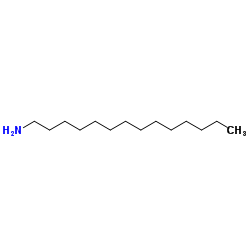1-Tetradecanamine

1-Tetradecanamine structure
|
Common Name | 1-Tetradecanamine | ||
|---|---|---|---|---|
| CAS Number | 2016-42-4 | Molecular Weight | 213.403 | |
| Density | 0.8±0.1 g/cm3 | Boiling Point | 291.9±3.0 °C at 760 mmHg | |
| Molecular Formula | C14H31N | Melting Point | 38-40 °C(lit.) | |
| MSDS | Chinese USA | Flash Point | 120.2±13.1 °C | |
| Symbol |


GHS07, GHS09 |
Signal Word | Warning | |
|
Controlling the size of hot injection made nanocrystals by manipulating the diffusion coefficient of the solute.
J. Am. Chem. Soc. 137(7) , 2495-505, (2015) We investigate the relation between the chain length of ligands used and the size of the nanocrystals formed in the hot injection synthesis. With two different CdSe nanocrystal syntheses, we consistently find that longer chain carboxylic acids result in small... |
|
|
Accurate assessment of the biodegradation of cationic surfactants in activated sludge reactors (OECD TG 303A).
Ecotoxicol. Environ. Saf. 118 , 83-9, (2015) The continuous-fed activated sludge test (OECD TG 303A) was used to predict the removal of cationic surfactants from wastewater in activated sludge plants. However, a method to differentiate between adsorption and biodegradation is not provided in these guide... |
|
|
Temperature- and pH-Dependent Shattering: Insoluble Fatty Ammonium Phosphate Films at Water-Oil Interfaces.
Langmuir 31 , 9312-24, (2015) We study the films formed by tetradecylamine (TDA) at the water-dodecane interface in the presence of hydrogen phosphate ions. Using Fourier transform infrared spectroscopy (FTIR), interfacial shear rheology, confocal fluorescence microscopy, cryo-scanning el... |
|
|
Inhibition by alkylamines of NADPH oxidase through blocking the assembly of enzyme components.
Jpn. J. Pharmacol. 80(3) , 237-42, (1999) Alkylamines inhibit NADPH oxidase both in intact neutrophils and in a cell-free system. The aim of this study was to examine the mechanism underlying this inhibitory effect. Among alkylamines with different chain lengths, the C12 compound (laurylamine) showed... |
|
|
[Chromatographic properties of tetradecylamine bonded stationary phase for reversed-phase liquid chromatography].
Se Pu 17(4) , 339-41, (1999) A novel bonded stationary phase, tetradecylamine bonded stationary phase (TABP), for reversed-phase HPLC was prepared by bonding 1-tetradecylamine to YWG-80 silica gel through 3-glycidoxypropyltrimethoxysilane. Hydrophobicity, selectivity and silanophilic act... |
|
|
NMR studies of restricted diffusion in lyotropic systems.
Solid State Nucl. Magn. Reson. 22(2-3) , 394-408, (2002) Tortuosity, 1/alpha, and surface-to-volume ratio, S/V, were determined in aqueous solutions of decylammonium, dodecylammonium and tetradecylammonium chlorides of various concentrations by measuring the apparent diffusion coefficient of water, D(app)(delta). T... |
|
|
Synthesis and anti-tuberculosis activity of glycitylamines.
Bioorg. Med. Chem. 24 , 693-702, (2016) A series of glycitylamines, which were prepared in few steps from readily available carbohydrates, were tested for their ability to inhibit tuberculosis growth in an Alamar Blue BCG colourimetric assay. Several derivatives, including (2R,3R)-1-(hexadecylamine... |
|
|
A clinical study of the effect of tetradecylamine on plaque formation.
J. Dent. Res. 30(3) , 399-402, (1951)
|
|
|
Antimicrobial properties of 2 aliphatic amines and chlorhexidine in vitro and in saliva.
J. Clin. Periodontol. 14(1) , 44-7, (1987) The surfactants tetradecylamine, hexadecylamine and chlorhexidine have been compared with regard to their ability to inhibit microbial growth. Antibacterial activity was assessed by tube dilution methods. Tetradecylamine and chlorhexidine were similar in anti... |
|
|
In vitro activity of lauric acid or myristylamine in combination with six antimicrobial agents against methicillin-resistant Staphylococcus aureus (MRSA).
Int. J. Antimicrob. Agents 27(1) , 51-7, (2006) The objective of this study was to investigate the in vitro activities of lauric acid and myristylamine in combination with six antimicrobial agents against methicillin-resistant Staphylococcus aureus (MRSA). The combination effect of lipids and antimicrobial... |